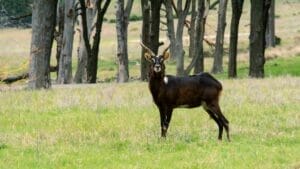
Appearance
Nile lechwe (pronounced lech-way) are a sexually dimorphic species, meaning that the males and females look almost nothing alike. While all calves are golden brown at birth, only females retain this coloration through life. In contrast, male Nile lechwe turn brownish-black with age and only they have horns, which are heavily ridged and lyre-shaped. Males also have a large white patch, or “saddle,” on their shoulders, and are about 20 percent larger than the females. The hindquarters of the lechwe are positioned higher than their shoulders, and they have widely splayed, elongated hooves that support them on muddy ground and while swimming.
Adaptations
Given that Nile lechwe have a reputation as aquatic antelope, they have a greasy, water-repellent coat and are excellent swimmers. Not only are they comfortable being submerged, but male Nile lechwe will even go into the water to fight. In the wild, Nile lechwe also take advantage of living in flood lands, and graze on the plants that spring up as floodwaters recede. As a result, they are able to take advantage of aquatic grasses, an abundant and underutilized food source.
Conservation
Since the 1980s, the areas Nile lechwe live in have seen varying states of turmoil. This cultural instability, as well as the increasing use of firearms and increasing cattle encroachment have all harmed this antelope.
However, the current largest threat is a hydroelectric dam built south of their native floodplains in Sudan. Due to the dam's disruption of seasonal flooding, it will likely impact the ecosystems that Nile lechwe and many other species rely on.
In order to help conserve the lechwe, in 2019 the Ungulate Taxon Advisory Group began looking for more facilities to house them. When some became available, Fossil Rim decided to add the species to our Game Preserve. Presently, the lechwe is on a bit of a trial run, where we only host a few individuals to see how they fare on our property. Eventually, we hope to grow our herd size.
Where are they?
Lechwe live in the fourth pasture you enter. They generally stay in a specific area off to the right on your way to the Giraffe Barn.
VIEWING TIPS
Nile lechwe can often be seen grazing near the giraffe barn.
Quick Facts
Scientific Name | Kobus megaceros |
Species Survival Plan | No |
Habitat | Floodplain, swampland |
Predators | Man, lions, leopards, Cape hunting dogs, Nile crocodiles |
Food | Aquatic grasses, floodplain vegetation |
Originally Native To | Republic of South Sudan, Ethiopia |
Characteristics | Males brownish-black with heavily ridged, lyre-shaped horns and large white patch on shoulders; females are golden brown; both have widely splayed, elongated hooves and greasy, water-repellent coat with hindquarters positioned higher than shoulders |
Offspring | 1 calf |
Lifespan | 12 years |
Social Behavior | Herds of 50 – 100+, depending on space available; both males and females are social. In captivity, usually large harem groups with one adult male, numerous females, and their offspring, as well as bachelor groups. |





